PF3D7_1115700 cysteine proteinase falcipain 2a (FP2A)
Disruptability [+]
| Species | Disruptability | Reference | Submitter | |
|---|---|---|---|---|
| P. falciparum 3D7 |
Possible |
21709259 | Theo Sanderson, Wellcome Trust Sanger Institute | |
| P. falciparum 3D7 |
Refractory |
USF piggyBac screen (Insert. mut.) | USF PiggyBac Screen | |
| P. berghei ANKA |
Possible |
RMgm-809 | Imported from RMgmDB | |
Mutant phenotypes [+]
| Species | Stage | Phenotype | Reference | Submitter |
|---|---|---|---|---|
| P. berghei ANKA | Asexual |
No difference |
RMgm-809 | Imported from RMgmDB |
| P. berghei ANKA | Gametocyte |
No difference |
RMgm-809 | Imported from RMgmDB |
Imaging data (from Malaria Metabolic Pathways)

Co-localization of full-length prodomain constructs with endogenous food vacuole proteins. Trophozoites transfected with proFP2-GFP (under falcipain-2 promoter) (a–c) or proFP3-GFP (under HSP86 promoter) (d–f) constructs were processed for immunofluorescence microscopy and labeled with anti-FP2 (a,d), anti-FP3 (b, e), or anti-PfCRT.Subramanian S, Sijwali PS, Rosenthal PJ. Falcipain cysteine proteases require bipartite motifs for trafficking to the Plasmodium falciparum food vacuole. J Biol Chem. 2007 282(34):24961-9.
See original on MMP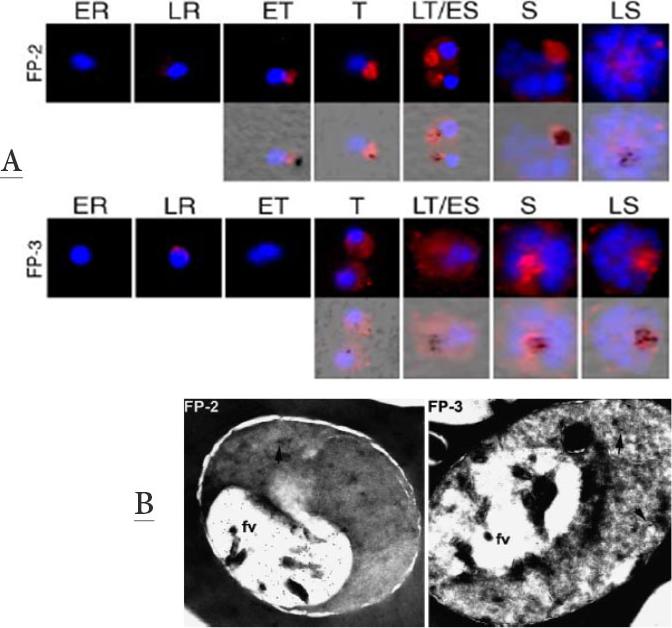
Upper panel: Localization of FP-2 and -3 by immunofluorescence across the erythrocytic life cycle: highly synchronous parasites were cultured and collected every 6 h (every 12 h for rings). Parasites were analyzed by immunofluorescence: parasites were incubated with anti-FP-2 or anti-FP-3 antisera, stained with Cy-3-conjugated secondary antibodies (red) and DAPI nuclear stain (blue), Images were merged with brightfield images to identify dark hemozoin crystals within food vacuoles (bottom panels). ER: early ring; LR: late ring; ET: early trophozoite; T: trophozoite; LT/ES: late trophozoite/early schizont; S: schizont; LS: late schizont. Falcipain-2 and -3 were localized to the food vacuoleLower panel: FP-2 and -3 localize to the food vacuole of trophozoites: frozen thin sections of early trophozoites (for FP-2) or late trophozoites (for FP-3) were incubated with primary anti-FP2 or anti-FP3 antisera, stained with secondary antibodies-conjugated to 10nM gold beads, and evaluated by immunoelectron microscopy. Food vacuoles are labeled (fv). Arrows indicate that FP-2 and -3 is also localized in structures outside of the food vacuole.Dahl EL, Rosenthal PJ. Biosynthesis, localization, and processing of falcipain cysteine proteases of Plasmodium falciparum. Mol Biochem Parasitol. 2005 139:205-12. Copyright Elsevier 2009.
See original on MMP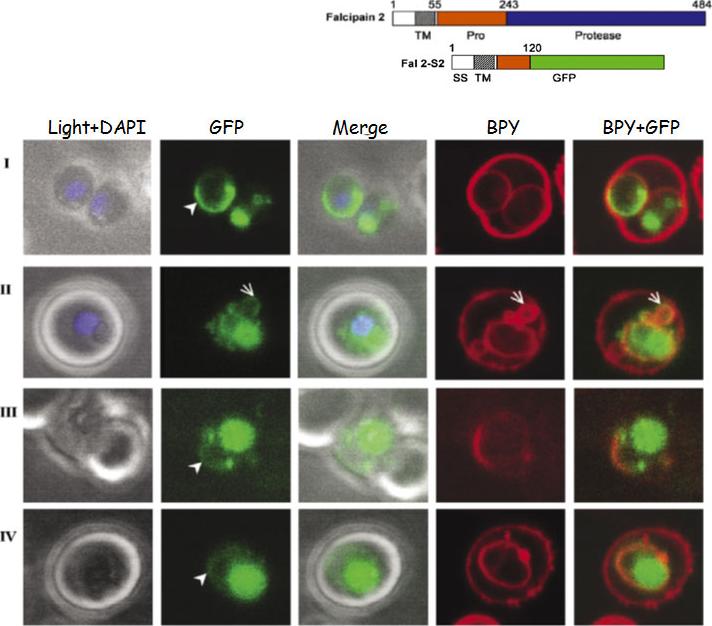
Labeling of Fal2-S2 transfectants with BODIPY-TR ceramide (BPY) at trophozoite stage. BODIPY-TR labels the erythrocyte membrane, PVM and food vacuole membrane. GFP fluorescence is seen overlapping with fluorescence by BODIPY-TR in the parasitophorous vacuole (arrowhead), trans vesicular network (panel II, pointed arrow) and in the food vacuoleiDasaradhi PV, Korde R, Thompson JK, Tanwar C, Nag TC, Chauhan VS, Cowman AF, Mohmmed A, Malhotra P. Food vacuole targeting and trafficking of falcipain-2, an important cysteine protease of human malaria parasite Plasmodium falciparum. Mol Biochem Parasitol. 2007 156:12-23. Copyright Elsevier 2009.
See original on MMP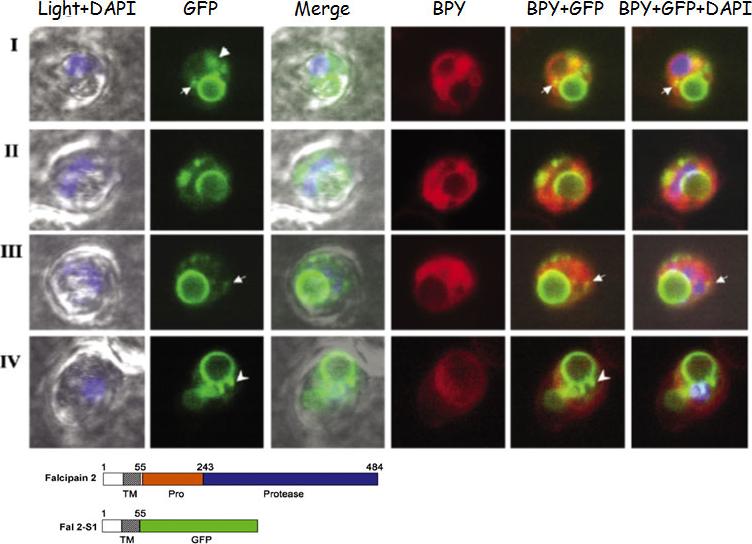
Labeling of Fal2-S1 transfectants with BODIPY-TR ceramide at trophozoite stage. GFP fluorescence is seen overlapping with fluorescence by BODIPY-TR in the PV and food vacuole membrane. Some of the small foci having GFP fluorescence near PV (solid arrows), show overlap with fluorescence by BODIPY-TR. Some of these foci in panel IV are seen fused with the food vacuole (arrow head).Dasaradhi PV, Korde R, Thompson JK, Tanwar C, Nag TC, Chauhan VS, Cowman AF, Mohmmed A, Malhotra P. Food vacuole targeting and trafficking of falcipain-2, an important cysteine protease of human malaria parasite Plasmodium falciparum. Mol Biochem Parasitol. 2007 156:12-23. Copyright Elsevier 2009.
See original on MMP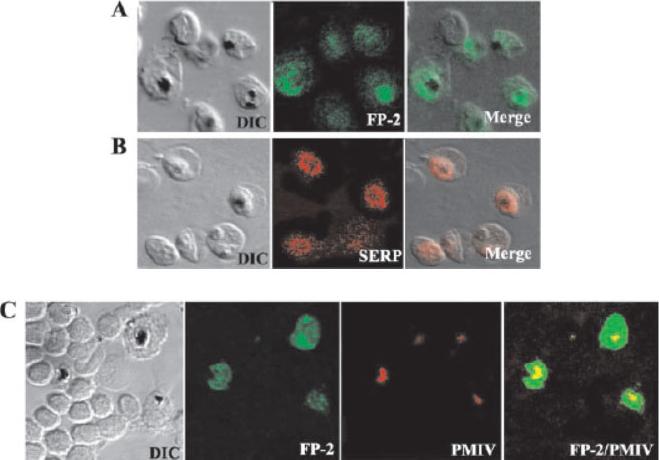
Immunolocalization of FP-2 by confocal microscopy. Erythrocytes infected with P. falciparum trophozoites were smeared on a glass slide, fixed with ice-cold methanol, and incubated with polyclonal FP-2 (A) or SERP (B) antibodies followed by Alexa 488 (green) or Alexa 594 (red) conjugated goat anti-rabbit IgG. Merged images of differential interference contrast (DIC) and fluorescence microscopy are shown on the right. C and D, slides were incubated with polyclonal FP-2 together with either plasmepsin IV (C) antibodies followed by Alexa-488-conjugated (green) goat anti-rabbit IgG and Alexa 594-conjugated (red) goat anti-mouse IgG. Merged images of green and red micrographs are shown on the right. The FP-2 antibody stained the entire trophozoite and vesicles or vesicle-like structures of unknown identity were seen extending into the erythrocyte cytoplasm. Co-staining of infected erythrocytes with antibodies to plasmepsin IV, which is present exclusively in the food, confirmed that FP-2 is present in the food vacuole as well as in the area that lies outside of the food vacuole (C). A comparison of FP-2 and SERP staining shows that the FP-2 is localized in the PVM as well as in a compartment that is distinct from the PVM.Dhawan S, Dua M, Chishti AH, Hanspal M. Ankyrin peptide blocks falcipain-2-mediated malaria parasite release from red blood cells. J Biol Chem. 2003 278:30180-6
See original on MMP
Trafficking of falcipain 2-GFP fusion proteins. Confocal microscope images showing expression and trafficking of Fal2-GFP fusion proteins at trophozoite stage of Fal2-S1. The chimeric GFP is visible in parasitophorous vacuole (arrow heads), and in the extension or evaginations of the parasitophorous vacuole (pointed arrows). Falcipain-2 is trafficked through a classical vesicle mediated secretory pathway involving endoplasmic reticulum and Golgi-like apparatusDasaradhi PV, Korde R, Thompson JK, Tanwar C, Nag TC, Chauhan VS, Cowman AF, Mohmmed A, Malhotra P. Food vacuole targeting and trafficking of falcipain-2, an important cysteine protease of human malaria parasite Plasmodium falciparum. Mol Biochem Parasitol. 2007 156:12-23. Copyright Elsevier 2009.
See original on MMP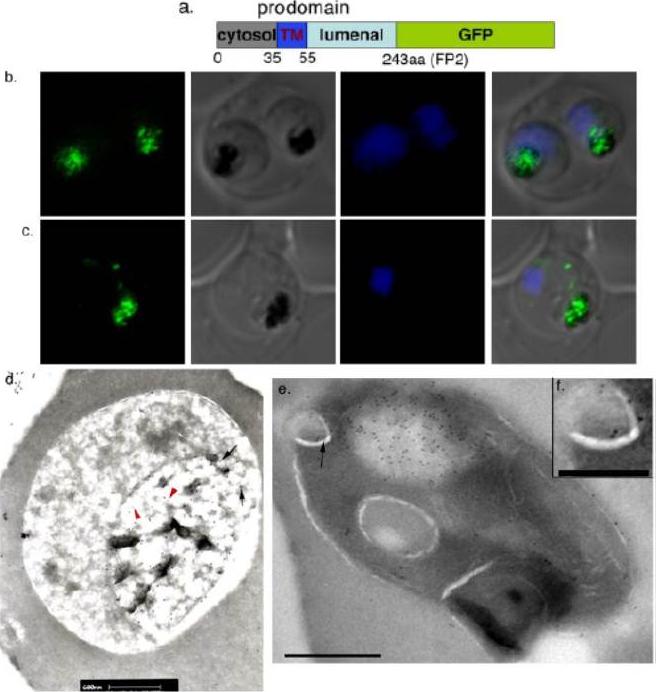
Localization of proFP-GFP wild type constructs. a, structure of the proFP2-GFP construct. Cytoplasmic (cytosol), transmembrane (TM), and lumenal portions of the prodomain are labeled. Confocal microscopic images show expression of proFP2-GFP (b) under the falcipain-2 promoter and proFP3-GFP (c) under the HSP86 promoter in young trophozoites. For this and other figures the panels show, from left to right, GFP, transmission light microscopy (black hemozoin pigment identifies the food vacuole), Hoechst staining of DNA, and a merged image. d, double immunogold labeling of an intraerythrocytic trophozoite transfected with a plasmid encoding proFP2-GFP. Native falcipain-2, labeled with antibody against the mature protease, is identified with 10-nm gold particles (red arrowheads) and GFP, labeled with anti-GFP antibody, is identified with 15-nm gold particles (black arrows). The bar indicates 0.6 mm. e, single immunogold labeling of an intraerythrocytic trophozoite transfected with proFP2-GFP and labeled with anti-GFP antibody. The arrow indicates a probable cytostome, shown in close-up in panel f.Subramanian S, Sijwali PS, Rosenthal PJ. Falcipain cysteine proteases require bipartite motifs for trafficking to the Plasmodium falciparum food vacuole. J Biol Chem. 2007 282(34):24961-9.
See original on MMPMore information
| PlasmoDB | PF3D7_1115700 |
| GeneDB | PF3D7_1115700 |
| Malaria Metabolic Pathways | Localisation images Pathways mapped to |
| Previous ID(s) | PF11_0165 |
| Orthologs | PBANKA_0932400 , PCHAS_0911900 , PKNH_0912800 , PKNH_0912900 , PKNH_0913000 , PVP01_0916000 , PVP01_0916200 , PVX_091405 , PVX_091415 , PY17X_0934400 |
| Google Scholar | Search for all mentions of this gene |